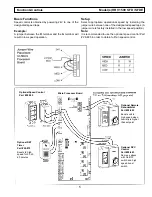
12
Ducting - Distribution
Stale Air Return System
The stale air return system is used to draw air from the
points in the building where the worst air quality problems
occur. Balancing dampers and/or adjustable grilles are rec-
ommended on all return air lines which are used during
installation to help balance the “draw” from different areas
of the building. Note that the installation should incorpo-
rate the use of balancing dampers and/or adjustable grilles
on all return air lines coming back to the unit.
Alternately, the stale air may be drawn directly from the
return air duct. When this system is used the air handler’s
blower will need to operate constantly when ventilation is
required. The exhaust takeoff connection must be at least
a meter from a directly connected HRV supply duct if both
are connected to the same duct run.
A damper located just prior to the HRV is required to bal-
ance the stale air exhausted with the fresh air supply
entering the building.
Return air suction points should be located at the opposite
side of the room to the fresh air inlet. The inlets may be
located in the ceiling or high on the walls and fitted with
inlet grilles.
Many commercial activities produce air contaminants in the
form of dusts, fumes, mists, vapors and gases. Contami-
nants should be controlled at the source so that they are
not dispersed through the building nor allowed to increase
to toxic concentration levels. The heat recovery ventilator
allows for economical operation of the HVAC system while
effectively removing contaminants from the space. In design-
ing the exhaust portion of the system the exhaust grilles are
placed so as to remove the contaminants while not allowing
them to enter the breathing zone of the occupants.
For contaminants that are lighter than air, grilles should be
located high on the wall. If contaminants are heavier than air,
a lower placement of the grilles will be required. Information
on a contaminants specific gravity and toxicity should be
available from the chemical data sheets.
Fresh Air Supply System
The fresh air supply ductwork from the HRV may be di-
rectly connected to the return air duct of the forced air sys-
tem. When directly connected it is recommended that the
air handler blower be in constant operation to move the
fresh air about the building Also, it is advisable to include a
short length of fabric flex duct or other nonmetallic connec-
tor in this hard ducted line in order to keep the HRV acous-
tically isolated and separately grounded (electrically) from
the air handler. This will avoid a possible shock hazard to
service people if a short to ground develops in one of the
devices. It may be necessary to install a separate fresh air
supply ductwork system if the heating is other than forced
air.
When installing an HRV, the designer and installer should
be aware of local codes that may require smoke detectors
and/or firestats in the HVAC or HRV ductwork. Because an
HRV is designed to bring fresh air into the building, struc-
tures may require a supply voltage interrupt when smoke
or flame sensors are triggered or central fire alarm system
is activated.
Supply air grilles may be ceiling or high wall mounted. Avoid
locating incoming fresh air grilles that could cause a direct
draft on the occupants as the incoming air may be below
room temperature. A reheat duct heater can be installed to
improve occupant comfort. The use of balancing dampers
or adjustable grilles as supply air diffusers and air exhaust
grilles are recommended.
Содержание 1500 SFDE
Страница 10: ...10 Roof Curb Detail for Model HRV 1500 SFDE ...
Страница 15: ...15 Wiring Diagram ...


































